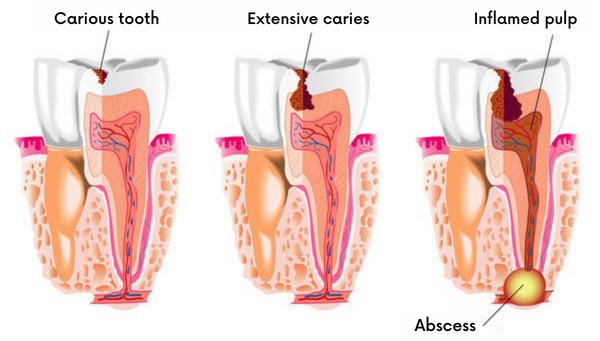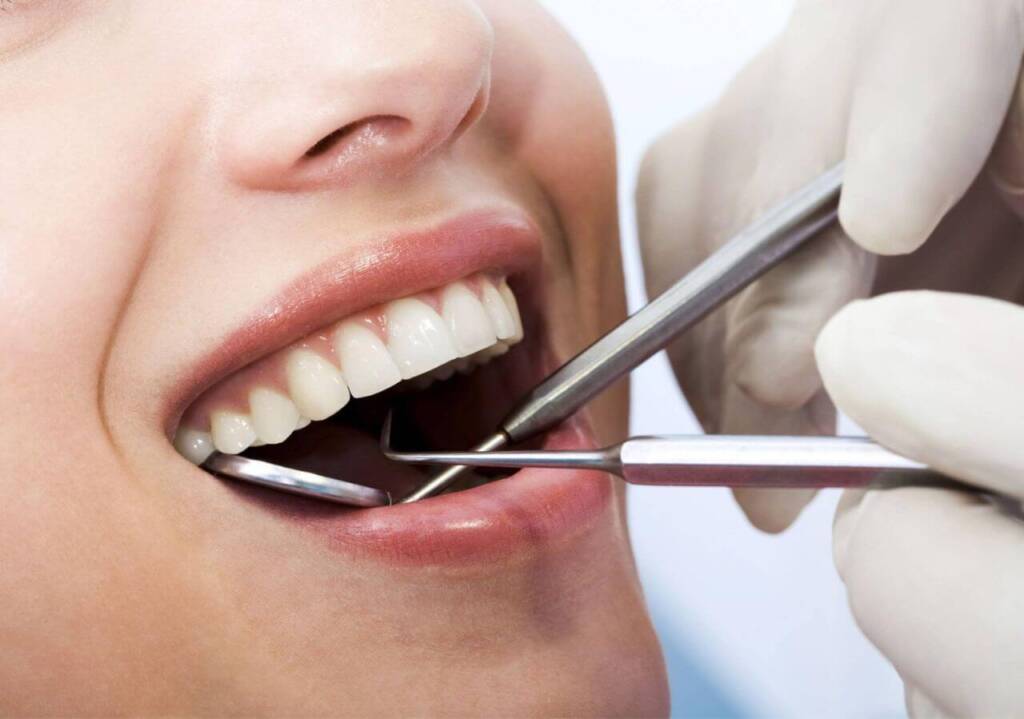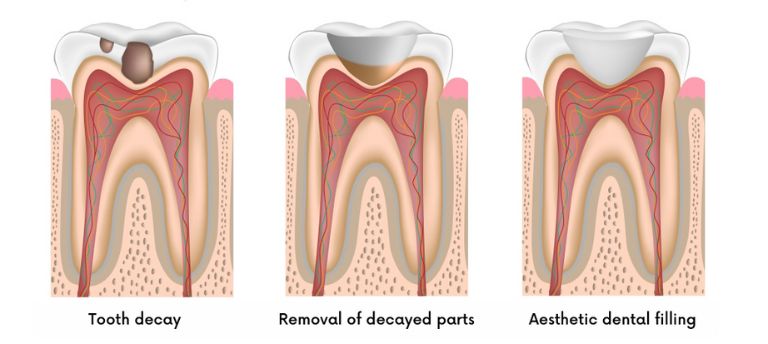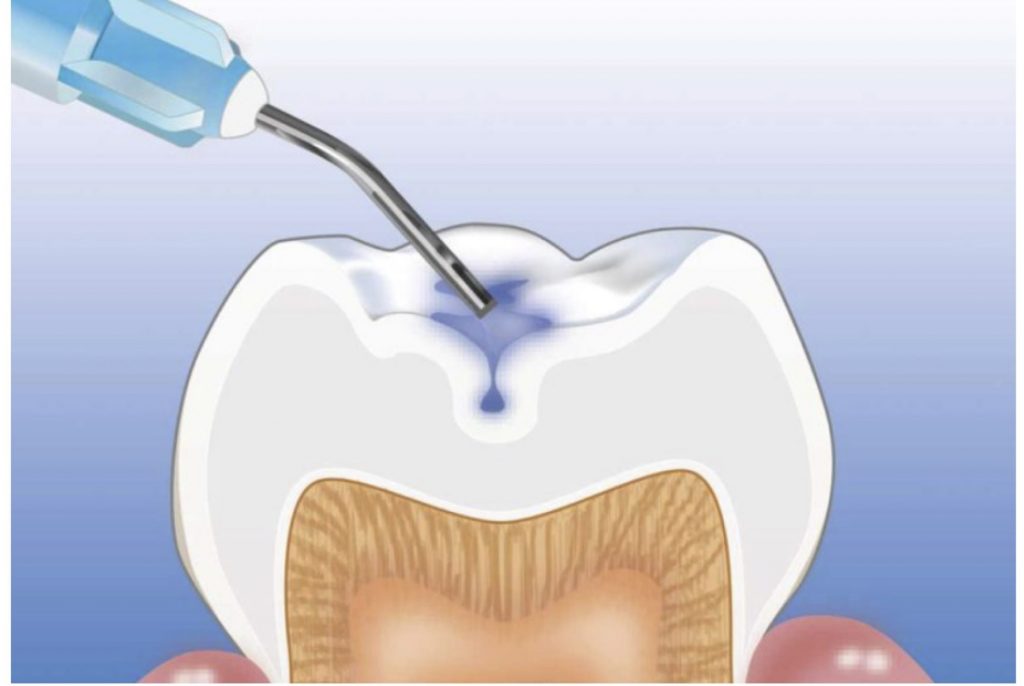Prevention of tooth decay
We do the most to preserve the health of our teeth when we go regularly, at least every six months, for a dental check-up or tartar removal.
Any minor changes can be noticed in time during the inspection and oral hygiene treatment. It is recommended to visit our dentist every six months for a dental check-up, even if you do not seem to have any complaints.

Replacement of amalgam filling
It is advisable to have our amalgam filling replaced by our dentist as soon as possible. Amalgam can have adverse effects, including certain allergic skin diseases, hair loss or other inflammation of unknown origin. In addition to the fact that its harmful components can dissolve with saliva, amalgam is not esthetic, and it can also discolor the gums and teeth. At our dental clinic, we only use aesthetic white dental fillings.

Types of dental filling
- amalgam filling
most dentists no longer recommend its use in practice, it is less durable, cannot fit the hole precisely enough, therefore caries can develop more easily next to it, substances harmful to health can be released from it - aesthetic white filling
it can be fitted more precisely in the tooth, sticks in, does not fall out as easily as amalgam. Its color is almost identical to that of the tooth, so it is barely noticeable to the naked eye. - inlay/onlay
a special type of filling for the treatment of decayed teeth. After proper preparation, the dentist places a precisely shaped inlay (onlay) in the prepared part of the tooth. It is recommended in case of greater tooth decay.
The aesthetic white dental tooth filling
At the Medicover Dental Clinic, our dentists work exclusively with aesthetic, white filling materials. It can be used to treat small and medium-sized caries in both front and chewing teeth. The filling material adheres extremely strongly and gap-free to the tooth tissue. The resulting filling is extremely durable and aesthetic.
Another advantage of the light-binding composite aesthetic tooth filling is that the original color and shape of the teeth can be restored. The aesthetic tooth filling is not simply white, but the dentist who performs the treatment mixes several colors in order to have a color as similar as possible to the given tooth, so the tooth filling becomes practically completely invisible.


The course of aesthetic dental tooth filling
- Removal of decayed teeth under local anesthesia
- Preparation of the walls of the cavity for the insertion of the filling material
- The dentist inserts the appropriate filling material into the prepared tooth
- It hardens the inserted filling with a special lamp, which protects the underlying surface similarly to tooth enamel.
- After the filling has hardened, the surface of the filling is smoothed and polished
Dental groove closing
Unfortunately, many people are not aware of the importance of groove closure, even though this method can largely prevent tooth decay that starts in the grooves. This treatment becomes necessary mainly in childhood, so parents should pay attention to this.
Groove closure is not painful at all, it only causes minor inconveniences for the child (sour taste, opening the mouth for a few minutes), so it provides a good opportunity to get to know the dentist and dentistry.
But what is a dental groove?
The dental groove is located on the chewing surface of the molars and molars, exactly between the prominent cusps necessary for chewing. These grooves can be too deep, in which case it is difficult to clean, so tooth decay can easily start.
The process of furrow closure
In all cases, the treatment begins with a thorough cleaning, and then, without drilling, the dentist applies a special, high-penetrating filling material to the surface of the tooth, which flows deep into the furrows, thus blocking the entry of plaque that causes caries.
The material guarantees the integrity of the underlying dentition for 2-3 years. After this, it is recommended to renew the groove seal, as it wears out.

Inlay, onlay
As a result of improper dental care or other physical or chemical effects, bacteria that are responsible for breaking down food can eventually multiply in the plaque that sticks to the tooth. However, the acids created in their wake begin to break down not only the food remains, but also the tooth tissue. This is how caries develops.
If the tooth decay is already in an advanced state, a plain dental filling will no longer be sufficient, as it does not have the necessary stability and load-bearing capacity.
In our dental clinic, our primary goal during our treatments is to preserve the teeth, so we also offer an aesthetic, natural-looking and long-lasting solution for larger cavities. Depending on the condition of the tooth, this solution can be an inlay or an onlay, which are simply called inlays.
In what cases is it recommended to use inlay or onlay?
Dental inlays should be used if the tooth decay affects a significant amount of the tooth, or if there is a risk that the decay may spread to neighboring teeth. It is customary to replace old, large amalgam fillings with inlays or onlays.
If the dentist considers that the chewing function and shape of the given tooth will not be suitable with the use of a plain dental filling, he may recommend gluing the insert. Inlay or onlay can also be an ideal solution for replacing broken or worn tooth tips, as a cover filling in the case of root canal treatment, and in the event that it is necessary to restore the bite height.
What are the advantages of inlays / onlays for you?
Teeth can be permanently restored with the help of dental inlays. They have a high load capacity, are aesthetic and have great chewing stability. The tooth can be preserved by using an inlay or onlay, and it is not necessary to grind down the crown for the replacement. The inlays are made by taking an impression in a dental laboratory, so they are completely unique and adapted to the patient’s characteristics.
It is also very important to mention that the dental inserts do not contain any allergens, so they can be used safely by anyone.
What is an inlay?
An inlay is a glued dental filling, a solid porcelain insert, which is individually prepared in a laboratory by a dental technician, and then glued in place. Inlay tooth filling is a technology used primarily for the construction of molars, when the tooth is broken or the decay is too great.
What is an onlay?
An onlay is also an inlay, so it is very similar to an inlay. The difference lies in the fact that the onlay is used in the case of a larger hole, when the entire chewing surface must be covered, and the damage to the tooth is already too great for an inlay to be placed on that surface, because not only the chewing surface, but also the tips of the teeth damaged and requires care.








